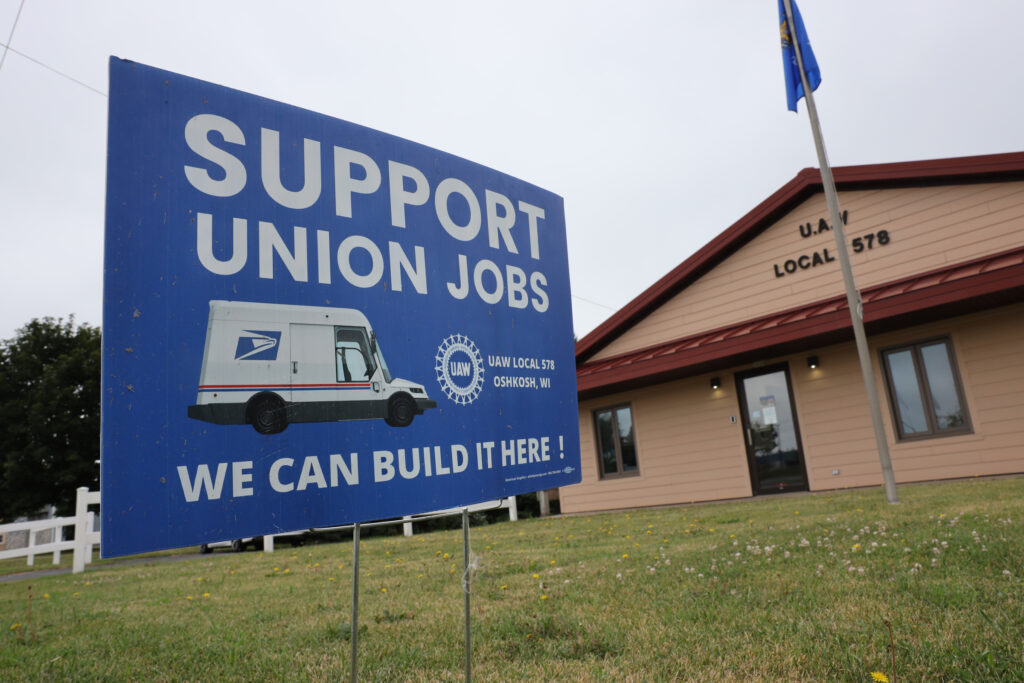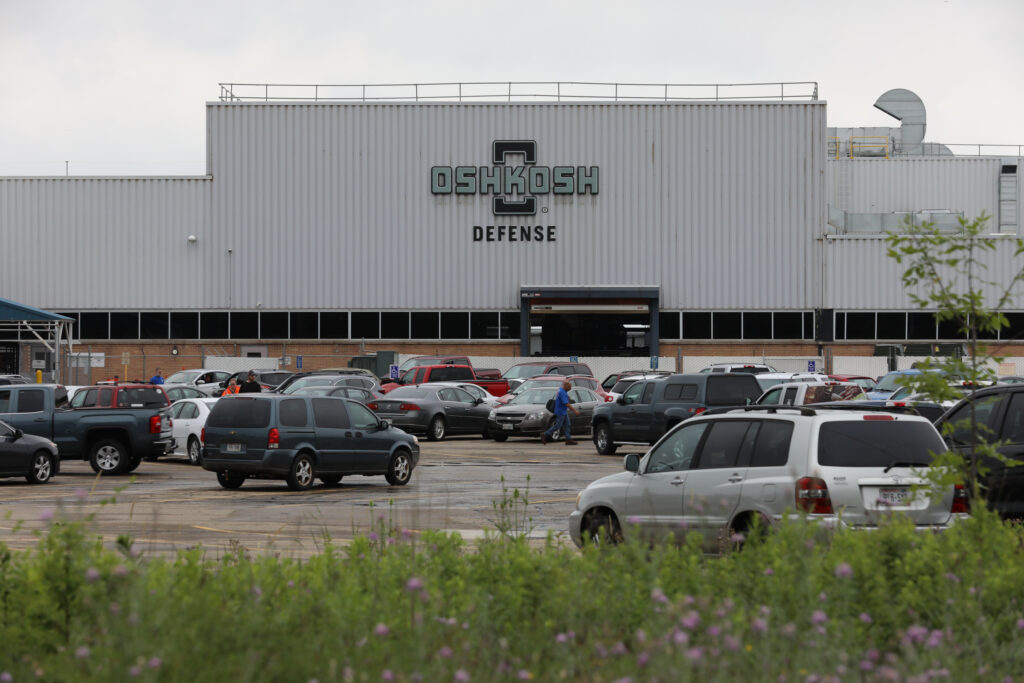This story was produced by Wisconsin Watch, a nonprofit, nonpartisan investigative reporting organization that focuses on government integrity and quality of life issues in Wisconsin.
- Download this story as a Word document
- Download the photos that accompany this story
- View the original story at WisconsinWatch.org
By Jacob Resneck
Wisconsin Watch

The news in early 2021 that Oshkosh Corp.’s defense subsidiary had secured a multi-billion dollar federal contract to build up to 165,000 postal trucks elicited a mix of pride and relief among Oshkosh, Wisconsin residents.
Since the end of the wars in Iraq and Afghanistan, the Pentagon has ordered fewer tactical vehicles, and employment has dropped at the corporation’s Oshkosh assembly plants.
So the 2021 announcement allowed the military contractor to tout a swords-into-plowshares pivot that would support at least a thousand more middle-class jobs for Wisconsinites, keeping the region’s manufacturing humming for another decade.
But the euphoria lasted barely four months. By June 2021, Oshkosh Defense announced it would not build tens of thousands of postal trucks in its existing Oshkosh assembly lines but shift production to a $155 million plant out of state. Instead of getting 1,000 new assembly workers, Wisconsin now stands to add around 100 design and administration jobs under the contract.
“I was really very proud that they won that postal contract,” Oshkosh Mayor Lori Palmeri said. “So then it was kind of a little bit of a whiplash when the announcement was made that it was going to South Carolina.”

Rather than build in its namesake city, the company will assemble next-generation postal vehicles about 900 miles away in Spartanburg, South Carolina at a 97-acre industrial site of a shuttered RiteAid distribution center. The center closed three years after receiving at least $500,000 in grants from local utilities plus tax breaks for creating jobs.
Oshkosh Corp.’s decision to make postal trucks in South Carolina has opened debate over how much loyalty a corporation owes to a community and state that have extended more than $70 million in tax credits and other incentives to support and keep the Fortune 500 defense contractor in Wisconsin.
Lawsuits challenge contract
The plan to build the postal trucks in South Carolina is being challenged in federal court by three lawsuits filed on April 28 — one brought by an unlikely alliance of environmentalists and organized labor and another by two environmental groups. And the third complaint — amended in June — was filed by 17 states, the District of Columbia, New York City and the air-quality board covering the San Francisco Bay Area. The Postal Service has moved for those cases to be combined and litigated in a D.C. courtroom.
The lawsuits claim the Postal Service violated the National Environmental Policy Act by choosing inefficient gas-powered vehicles to replace its fleet. The lawsuit by the Natural Resources Defense Council and the UAW also claims the contract undercuts a long-established unionized workforce — claims the Postal Service denies.
The pressure may be working. Last month, the Postal Service announced that at least half of the new vehicles would be electric, after all. It also limited its commitment to Oshkosh Defense to the initial $2.98 billion order for 50,000 postal trucks.

In a July 28 call with investors, Oshkosh Corp. CEO John Pfeifer rejected any suggestion that the postal service was backpedaling on the deal or that his company could not produce enough battery electric vehicles.
“Everything that’s happening with the U.S. Postal Service is positive for us,” he told investors. “All parties involved want to see more electric, faster.”
He added that 50% “is not an upper bound by us — if USPS wants to go to 100%, we can go to 100%. (electric).”
But in a concurrent filing with federal regulators, Oshkosh Corp. disclosed that building its South Carolina plant poses risks, including that “the costs and other challenges associated with recruiting and training a new workforce may be greater than we anticipate.”
Pfeifer told investors that the Postal Service’s sudden announcement that it plans to replace some of its fleet with at least 34,500 commercially available “off the shelf” vehicles from other vendors would not hurt the company’s bottom line.
But it does raise questions about just how many vehicles the Spartanburg plant will ultimately produce for the Postal Service.
The corporation also stated that: “Budget constraints facing the USPS and continuously changing demands for postal services may result in the USPS ordering fewer units than we expect the USPS to award to us under the contract.”
Still, the move by the postal service to build more EVs and dial back its commitment to solely source from Oshkosh Defense has won plaudits from environmentalists. Labor leaders say they still want stronger commitments that Oshkosh’s existing workforce won’t be sidelined.
“We care just as much about the environment as anyone else,” UAW’s national vice president Cindy Estrada told Wisconsin Watch. “Our position has always been: We want Oshkosh (Defense) to get the electric vehicle work. But we also want them to do it under a union contract where there’s democracy in the workforce.”
An Oshkosh Defense spokesperson reiterated the corporation’s commitment to build its postal trucks at its new plant in South Carolina. Production is scheduled to start in August 2023.
Officials and workers are now eyeing another huge federal contract likely to be awarded by early 2023 that could either boost Oshkosh Corp.’s in-state manufacturing — or send even more jobs out of state where workers aren’t organized and wages are cheaper. An Oshkosh Defense official told Wisconsin Watch the company is “laser-focused” on keeping that work in Wisconsin.
More than $70 million in tax subsidies
This is not the first time in recent history that Oshkosh Corp. has threatened to step away from the city where it has been rooted for more than a century. In 2017, company officials aimed to move the corporate headquarters out of town — a plan that was thwarted only after Oshkosh city officials agreed to sell the company prime public land on Lake Butte des Morts and offer significant tax incentives.
That large companies play governments against each other is not new. But looking closer, Oshkosh Defense’s postal contract is arguably not a matter where one community wins and another loses.
South Carolina’s incentives include a $9 million grant, plus a locally-approved 40-year property tax break. But this all comes at a cost to its own community as it struggles to fund its public schools. And it creates a conundrum for governments: Lose jobs that fuel the economy or keep the jobs but lose tax revenue to fund the government?
Many elected officials in Wisconsin are careful not to directly criticize a major employer like Oshkosh Corp. for its decision to send production south of the Mason-Dixon.
“My fear is that we try to stop this — hold it up — and at the end of the day, we lose the contract entirely,” Winnebago County Executive Jon Doemel said, adding that financial health of the company is important for the more than 6,000 employees in the Oshkosh area.
Reflecting on the competitive environment, he draws an analogy of a 1990s-era video game.
“SimCity taught us really quick that if you lower the taxes, some people grow, but everything goes to crap,” he said. “Or if you raise taxes, everybody leaves. It’s about finding that equilibrium.”
Lack of capacity cited for move
Oshkosh Defense says it had considered several sites around the country to build postal trucks — including in Wisconsin — but struggled to find existing buildings with the needed 825,000 square feet of capacity.
“Wisconsin simply did not have any available buildings that could meet this requirement,” Oshkosh Defense spokesperson Alexandra Hittle told Wisconsin Watch in an email, “and given the strict timing requirements of this program, building a new facility was not feasible.”
Union members in Oshkosh doubt that claim, with some calling it a potential attempt to weaken the local United Auto Workers union, which has represented assembly workers since 1938.
UAW Local 578 President Bob Lynk questioned why the company’s $155 million investment on a new plant in South Carolina pencils out unless it sees savings on labor costs.
“We could build that truck here – they’re just choosing not to,” he said.
“Nothing against South Carolina,” Lynk added, “but they’re not going to get paid what we get paid here (in Oshkosh).”
There’s been no official word on wage scale in Spartanburg. But an online marketplace has begun advertising Spartanburg County-based management positions in engineering, accounting and logistics that require a college degree.
Online job ads indicate the lowest rung starts at $8.30 an hour — barely a dollar over the federal minimum wage. According to a redacted copy of the 73-page postal truck contract obtained by Wisconsin Watch, the only provision relating to pay is a requirement to offer at least the federal minimum wage of $7.25 an hour.
The advertised wage is half as much as an entry-level plant employee in Oshkosh, where union members start at $15.99 an hour, and no college degree is required.
Oshkosh Defense would not comment on comparable wage scales. Hittle would only say Oshkosh Defense plans to offer a “competitive wage and benefit plan” in South Carolina when it begins hiring assembly workers next year.
Union jobs going away
Wisconsin’s elected leaders say the lure of cheaper labor and generous subsidies are eroding the region’s manufacturing base.
“This isn’t the first time South Carolina, and that part of the country has thrown incentives, with no accountability, trying to poach existing businesses,” said Assembly Minority Leader Rep. Gordon Hintz, D-Oshkosh, and a member of the Wisconsin Economic Development Corp.’s board of directors.
Oshkosh Defense has been sending jobs to non-union states for several years. The company outsourced up to 300 assembly jobs to a non-union plant in Jefferson City, Tennessee in 2019.
The company declined to comment on that decision.
“We don’t publish employment levels by facility,” Hittle wrote, adding that the company plans to expand production and add 200 jobs at subsidiary Pierce Manufacturing’s plants in Neenah and Fox Crossing that build fire trucks.
Union leaders in Oshkosh say they’ve seen a steady decline in work. Production on military vehicles has slowed, with about 1,500 UAW members currently working in Oshkosh plants. That’s about half the unionized workforce from a decade ago when the corporation’s military contracts helped it rebound after the 2008 recession.
That year, the downturn plunged Oshkosh Corp. shares from around $40 to around $5 in six months. (In the last year it fluctuated between $125 and $80 in daily trading on the New York Stock Exchange).
Company has ‘near-death experience’
During the recession, “Oshkosh (Defense) had a near-death experience,” said defense analyst Loren B. Thompson of the Lexington Institute, a think tank funded by defense contractors including Oshkosh.
He added: “And more than anything else, what saved it was a series of contracts for the U.S. Army in order to build highly armored vehicles that could survive improvised explosive devices in Iraq and Afghanistan.”
In 2009, Oshkosh Corp. sought support from state and local governments to give it a competitive edge to win those contracts. It built a 150,000-square-foot electropainting processing facility, allowing it to secure a contract for its Family of Medium Tactical Vehicles (FMTV). The deal, worth more than $3 billion, created about 2,000 jobs in Oshkosh.
To make that happen, the state of Wisconsin initially paid for about two-thirds of the $51.5 million cost of the e-painting facility through tax credits. And the city of Oshkosh borrowed $5 million in bonds to finance the project at a cost to taxpayers of around $8 million including administration and interest.
City financial consultants reported that the company likely would not have received the lucrative FMTV contract without the city’s $5 million grant. City staff had asked about a low-interest loan but were reportedly told the corporation was already overleveraged and couldn’t afford any more debt.
The Wisconsin Economic Development Corp.’s investment in Oshkosh Corp. — tied to job creation and retention — eventually increased to $55 million in state tax credits. In return, the company maintained at least 1,000 jobs at a minimum $25 an hour, and has since built at least 41,000 of these medium-duty trucks. “We have met all commitments related to any applicable incentives,” noted Hittle, the company spokesperson.
Driving public investment in private sector manufacturing in Wisconsin: an acknowledgement of the economic firepower of blue collar assembly jobs.
“The state’s thousands of manufacturers contribute more to the overall workforce and economic output here than in almost any other state,” the nonpartisan Wisconsin Policy Forum wrote in its 2018 report.
The analysts wrote that manufacturing jobs offer middle class wages in less populated areas to workers with modest education who might struggle to find comparable opportunities elsewhere.
And then there’s the knock-on effect: “Manufacturing jobs are seen as having higher multiplier effects than other jobs, meaning that gaining or losing them will have a greater effect on other jobs in the region,” the report said.
‘We weren’t even a contender’
Five years ago, the community was put on notice not to take Oshkosh Corp.’s huge economic footprint for granted. In 2017, the company notified the city that it needed a new headquarters and was looking at sites out of town.
When the city ordered a wetlands study for suitability of development in advance of a potential sale of the municipal golf course, Oshkosh City Manager Mark Rohloff downplayed whispers that Oshkosh Corp. was eyeing the public recreation area for a new headquarters.
But less than four months later, the deal had crystallized: either sell off prime parkland where Lake Butte des Morts meets the Fox River — or the company would leave Oshkosh.
“The way it was explained, we weren’t even a contender until, you know, we kind of scrambled and looked at that (site) as a potential,” recalled Palmeri, who was a council member at the time.
For a city that lost its last OshKosh B’Gosh clothing factory in 1997, such a move would be disastrous for the local economy. Public opinion was divided over closing the golf course, but the council ultimately approved the deal in a unanimous 6-0 vote.
“To use the term divide and conquer, I think that’s kind of what happened in our community: that either you were for the golf course or for Oshkosh Corp,” recalled Andy Buck, a trades union organizer who was subsequently elected to represent Oshkosh’s western outskirts on the Winnebago County Board of Supervisors.
Oshkosh Corp. paid the city $3.5 million for a 32-acre portion of the now-closed public golf course. The city paid more than $7.2 million to extend roads, utilities and other infrastructure and a $6 million tax incentive payable over 12 years.
The corporation built a 191,000-square-foot glass-and-steel headquarters which quickly earned the nickname “Glass Palace.” The rest of the municipal golf course was converted into a city park, which mollified some of the deal’s critics.
The state of Wisconsin provided a further $8 million in state tax credits to keep the headquarters’ 450 employees in Oshkosh. Then-Gov. Scott Walker thanked Oshkosh Corp. “for its ongoing commitment to Wisconsin.”
South Carolina beckons
But three years later, that commitment did not keep the company from being enticed by South Carolina, a state long known for its generous incentives for large corporate employers.
Oshkosh Corp. CEO John Pfeifer told Wisconsin Public Radio in June that the company considered “multiple” sites in Wisconsin but in the end “we just had to make an objective decision.” He added that the state still will get “hundreds of new jobs” under the contract.
Spartanburg County officials negotiated a 40-year tax incentive for Oshkosh Corp. to build its new postal truck plant there. The deal, announced in 2021, will slash property taxes by 40% over 40 years, plus offer the company $3 million over four years to offset its property taxes. Although the company says it plans to create up to 1,078 jobs, it will qualify for the property tax breaks by investing at least $150 million and keeping just 125 people on the payroll.
Such incentives also come at some expense to local schools, which rely heavily on property taxes for funding.
“South Carolina has ranked number one in terms of the self-reported revenue loss by school district,” Christine Wen, a researcher with Good Jobs First, told reporters after releasing a recent report on South Carolina’s tax incentives.
“Because disclosures of public performance are so scant there, we don’t know that these projects are paying off. But we do know that school districts are losing over $500 million now a year,” Wen said. “And it’s been going up at approximately $15 million every year since 2017.”
Educators in the Palmetto State report schools with crumbling facilities, including some with no air-conditioning, said Sherry East, president of the South Carolina Education Association.
“These deals are kind of behind the scenes deals that go on,” East said. “And no one really knows the cost.”
Good Jobs First, an economic nonprofit with ties to organized labor, estimates South Carolina’s tax abatements have cost its local schools $2.2 billion between 2017 and 2021.
“That’s real money — and that’s why the harm to schools is so profound,” Good Jobs First Executive Director Greg LeRoy told reporters in May.
Wisconsin’s competition with states like South Carolina that aggressively sacrifice funding for local services to lure big companies like Oshkosh Corp. frustrates elected officials like Buck.
“We’ve done everything that’s asked of us as citizens and community members to work with the company to stay in our community,” Buck said. “Generations of folks have worked at Oshkosh Corp.”
He added: “This is a career that you can retire at, after 30, 35 years. I mean, how many careers are out there that you can do that now?”
Next big contract looms
In Northeast Wisconsin, the focus has already shifted to the next big federal contract. Much of Oshkosh Corp.’s good fortune can be traced to the success of its Joint Light Tactical Vehicle (JLTV) — a truck it designed to largely replace the U.S. Army’s Humvee.
Its main defense subsidiary plans to keep building the military vehicles in its existing plants.
“We will remain laser-focused on ensuring JLTVs under the follow-on contract are built right here in Oshkosh, Wisconsin,” Hittle told Wisconsin Watch.
Even though Oshkosh Defense developed the vehicle and has been producing it since 2015, the blueprints now belong to the Pentagon. The contract is being re-bid, and there’s fierce competition for the roughly $7.3 billion dollar prize.
“It’s quite rare for the Army to award a contract of this size, particularly for vehicles,” said Thompson, the defense analyst. He said Oshkosh Defense has a good track record with the military but that the Defense Department is looking at its own bottom line.
During a springtime call with investors, a bullish Pfeifer, the CEO of Oshkosh Corp., expressed confidence that the defense contractor will keep making the vehicles. He referred to the U.S. Army’s open bidding to build 16,600 new vehicles and 10,000 trailers as a “huge contract extension.”
“This will take the program into the 2030s,” Pfeifer said.
But in legal filings, the company admits it’s not in the bag.
“There are a number of competitors vying for the new contract, and there is no assurance that we will be successful in competing for the new contract,” it wrote in its July 28 filing with the Securities and Exchange Commission.
There are also concerns over how long these lucrative defense contracts would continue to be assembled by unionized workers in Wisconsin, a loss which local officials say would be “devastating” for the regional economy.
“There is a secular (long-term) trend of the U.S. vehicle industry gradually migrating to the South,” Thompson said.
“To the best of my knowledge,” he added, the Pentagon’s procurement process does not give preferences to unionized workforces. And lower labor costs generally increase profits and make firms more competitive.
That worries state lawmakers like Hintz, who grew up and lives in Oshkosh. He says a shrinking and aging workforce makes faster-growing states like South Carolina attractive to employers.
“The concern is, will some of the existing jobs here be shifted down there? Either for low cost, anti-union, non-union reasons,” Hintz asked, “or because we simply don’t have the workforce to fill the jobs to meet the demand?”
If Oshkosh Defense does not win the contract, Lynk says 70% of his current members could be out of work. Which is why the effort to claw back the postal vehicle contract is so important.
“We supported Oshkosh (Corp.),” he said. “It’s time for Oshkosh to do the right thing.”
This story is part of the NEW News Lab, a consortium of six news outlets covering northeastern Wisconsin. The nonprofit Wisconsin Watch collaborates with WPR and other news media and the University of Wisconsin-Madison School of Journalism and Mass Communication. All works created, published, posted or disseminated by Wisconsin Watch do not necessarily reflect the views or opinions of UW-Madison or any of its affiliates. This story is a collaboration between Wisconsin Watch and WPR as part of the NEW News Lab, a consortium of six news outlets covering northeastern Wisconsin.



